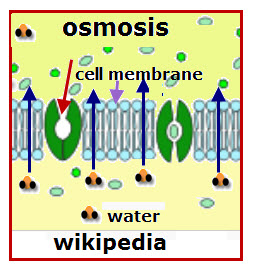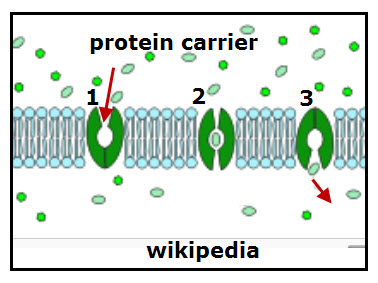

Passive Transport:
passive: no energy is required
transport: to move through a cell membrane.
Passive transport is the movement of molecules through a cell membrane without expending any energy.
Types of Passive Transport In and Out of Cells.
1. Simple Diffusion is a passive transport in which particles pass through the plasma membrane surrounding a cell.
Diffusion is the random movement of particles with the net direction of the particles being from an area of higher concentration to an area of lower concentration.
As a rule, polar molecules cannot freely pass through a cell membrane, but because of the size of water molecules, which are polar, they can freely move through a cell membrane.
OSMOSIS is a special type of passive transport. Osmosis is also a special type of diffusion in that osmosis is the specific name for the transport of water molecules through a cell membrane.
Water molecules are polar, but are small enough to pass through cell membranes. The direction of water flow depends on the concentration of solutes dissolved in the water.
cell membranes are permeable to water molecules, but generally it is not to the solutes dissolved in the water.
Water moves through a cell membrane from a
hypotonic (low solute concentrated) solution
to a
hypertonic (high solute concentrated) solution.
2. Facilitated diffusion is an example of passive transport. Facilitated transport might be a better title because particles are not diffusing through cell membranes. Instead, particles, such as sugars, and amino acids, depend on carrier proteins imbedded in the cell membrane that facilitate their moving from one side of the cell membrane to the other.
In the diagram from Wikipedia, Facilitated Diffusion, a model for the movement of a particle through a protein carrier is shown.
1. One side of the protein carrier is open so that a particle can enter and move through the carrier to the opposite side of the cell membrane.
Notice how many particles are floating around in the solution. The solution on this side is more concentrated with particles, and thus the carrier opens to let one of the particles enter.
2. The protein carrier closes.
3. The protein carrier opens and the particle moves out of the carrier and into the solution.
Notice how few particles are floating around in the solution the transported particle moves into. This solution with fewer particles is less concentrated with particles.
The diagram over simplifies the transporting process. Each carrier protein binds to specific molecule, changes shape and then releases the molecule on the opposite side of the membrane. Once the transaction is complete the proteins return to their original position. Protein carriers can transport particles into or out of a cell.
FYI: A protein channel is another type of passive transport facilitator. Ion channel proteins allow specific ions to pass through the protein channel. The ion channels are regulated by the cell and are either open or closed to control the passage of substances into the cell. Again, materials that move into or out of the cell by passive transport move in a direction to achieve equilibrium–comparable concentrations on either side of the membrane (isotonic solutions)
Biology for Every Kid
How is water transported through plant stems?What’s the effect of osmosis on a raisin?
What’s the best way to grow penicillin?
How are butterflies different from moths?
You will discover the answers in this book.
(Paid Link)
Big Book of Science Experiments
A book of fun informative experiments about astronomy, biology, chemistry, earth science, and physics.
(Paid Link)



